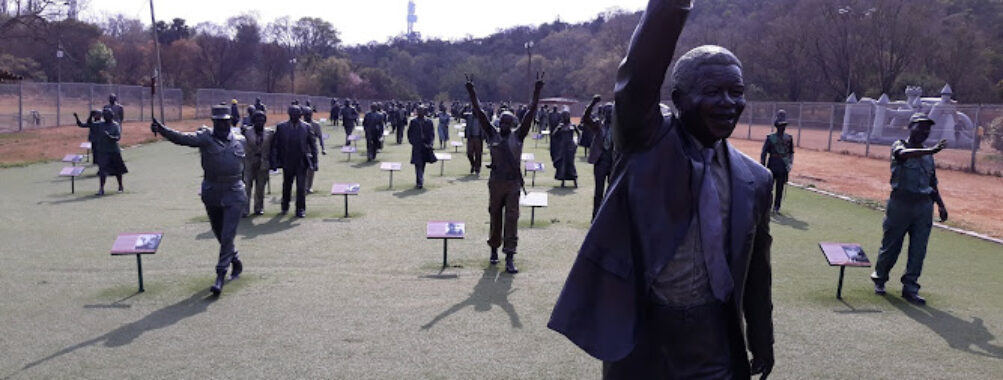
The Long March to Freedom
“`html
Table of Contents
Description
The Long March to Freedom is one of those places that quietly pulls you in before you even realize it. Set against a backdrop of open skies and rolling South African landscape, this outdoor monument isn’t just another collection of statues—it’s a living timeline. Each bronze figure tells a story of courage, struggle, and the relentless pursuit of equality. Walking through the rows feels like stepping into history itself, where the air seems to hum with the voices of those who fought for justice.
There’s something deeply personal about seeing the faces of leaders and everyday heroes cast in bronze, each one frozen mid-stride, as if still marching toward freedom. The artistry is striking—some statues look almost ready to move, their eyes fixed ahead with unshakable resolve. I remember the first time I visited; I found myself standing in front of a figure I’d read about in school, and suddenly, history wasn’t just a chapter anymore—it was right there in front of me.
While it’s undeniably educational, The Long March to Freedom doesn’t feel like a museum. It’s more like a conversation between past and present. You’ll see families walking together, kids asking questions, and travelers pausing for long moments of reflection. Sure, not every visitor is moved in the same way—some might find it a bit heavy or even overwhelming—but that’s part of its honesty. It doesn’t sugarcoat history; it invites you to feel it.
The layout of the site is clever too. As you move through the procession, you can almost trace the evolution of South Africa’s freedom movement—from early resistance to modern-day democracy. Each statue represents a chapter, and together they form a story that’s as painful as it is inspiring. If you’re the kind of traveler who loves places that make you think, this one will stay with you long after you’ve left.
Key Features
- Over 100 life-sized bronze statues depicting historical figures from South Africa’s liberation struggle
- Beautifully landscaped outdoor setting perfect for walking and photography
- Educational plaques offering background on each figure’s contribution to freedom
- Guided tours available for deeper insight into South Africa’s history
- Family-friendly environment with open spaces for children to explore safely
- Accessible pathways suitable for wheelchairs and strollers
One thing that really stands out is how approachable the space feels. You’re encouraged to walk among the statues, touch them, and take your time. There’s no velvet rope keeping you at a distance—just you, the art, and the history it carries. And honestly, that’s what makes it so powerful.
Best Time to Visit
If you’re planning your trip, try to visit in the cooler months—April through September tends to offer the most comfortable weather. The midday sun can be pretty intense, especially since much of the area is open. Early morning or late afternoon visits are ideal; not only is the lighting perfect for photos, but the shadows cast by the statues create a hauntingly beautiful effect.
During weekends and public holidays, you’ll likely find more visitors, including local families and school groups. It’s a lively atmosphere, but if you prefer a quieter, more reflective experience, go on a weekday. I once went on a Tuesday morning, and for a good half hour, it felt like I had the entire march to myself—just me and the bronze faces watching the horizon.
How to Get There
Reaching The Long March to Freedom is fairly straightforward. It’s located within easy driving distance from central Pretoria, and the roads leading there are well-maintained. If you’re coming from Johannesburg, it’s about an hour’s drive depending on traffic. There’s ample parking on-site, and taxis or rideshare services can drop you right at the entrance.
For those who prefer public transport, there are local bus routes that stop not too far from the site, though walking the final stretch might take a bit of time. Honestly, if you can, rent a car—it gives you the freedom to explore nearby attractions at your own pace. And trust me, there’s plenty in the area worth seeing once you’ve finished your visit here.
Tips for Visiting
Here’s the thing about The Long March to Freedom—it’s not just a quick photo stop. To really appreciate it, give yourself at least an hour or two. Bring water, wear comfortable shoes, and don’t forget sunscreen. The open-air layout means you’ll be in the sun for most of your visit, and there’s not a ton of shade.
If you’re traveling with kids, you’ll be glad to know it’s a welcoming space for families. There’s room for them to move around and explore, and the statues often spark great conversations about history and courage. For photographers, the golden hour here is pure magic—the bronze glows, the shadows stretch long, and the whole scene feels timeless.
I’d also recommend reading up on a few of the figures before you go. Recognizing a name or a story when you see the statue adds a layer of connection that’s hard to describe. And if you’re someone who enjoys journaling or sketching, bring your notebook—you’ll probably find yourself inspired.
Lastly, take a moment at the end of your walk to just stand still and look back at the line of statues disappearing into the distance. It’s a humbling sight. The Long March to Freedom isn’t flashy or loud—it’s steady, grounded, and profoundly human. For travelers seeking meaning beyond the usual tourist stops, this place delivers that in spades.
“`
Location
Places to Stay Near The Long March to Freedom
Find and Book a Tour
Explore More Travel Guides
No reviews found! Be the first to review!